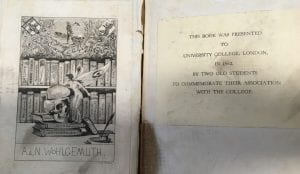Cataloguing Mysteries: Engravings of the Electors of Bavaria
By Harriet S, on 15 November 2018
Retrospective cataloguing can be a great way of unearthing treasures in UCL’s extensive collections. Few other librarians will be so systematically working through a subject or donation from many years ago, and many of the texts are hidden until cataloguing, with only the bare bones of an online record or in some cases nothing at all.
The most recent mystery comes from the unlikely source of 20th century art books being catalogued for storage. Amongst the unremarkable, modern volumes was a small book of engravings. The only text included in the book is instructions from the bookbinder in German (“An den Buchbinder”), and nothing about the text gives much of an idea of its publication or provenance.
An afternoon with UCL’s conservators revealed some probable dates, as the book uses rag pulp paper so would likely have been produced before the widespread adoption of wood-pulp paper (circa 1837), and the binding has many 18th century features such as red bole edges and French Style laced boards, alongside some more recent elements. Already the book was looking to be much older than its shelf-mates.
Perhaps the most unique identifier at this stage was a watermark of the coat of arms of Bavaria, and a letter (M? W?) visible below it. The database of watermarks at Memory of Paper described a similar watermark on a music manuscript at Bayerische Staatsbibliothek but without any image available, the only option to verify the watermark was to contact the library directly and request one.
By some coincidence, the Bayerische Staatsbibliothek was conducting watermark research at the time and were kind enough to send an image, verifying that this was indeed by the same paper-maker: Matthias Weitenauer, active 1763-1773. However, as the final engraving is of Karl Theodor, who only became Elector in 1777, the book as a whole would have had to come together after Weitenauer’s presumed working period. So, other than the knowledge the book was not created before the paper it’s printed on, an exact date was still not forthcoming.
 To get a more concrete date, the priority was to identify the engravers. 2 out of the 62 engravings were signed: Weissenhahn Sc[ulpsit], likely to be Georg Michael Weissenhahn (1741-1795) who engraved portraits in this period, although none of this book’s portraits seem to be discoverable online. It is likely that the other 3 engravings in a similar style are also by Weissenhahn, which left a mere 57 unaccounted for!
To get a more concrete date, the priority was to identify the engravers. 2 out of the 62 engravings were signed: Weissenhahn Sc[ulpsit], likely to be Georg Michael Weissenhahn (1741-1795) who engraved portraits in this period, although none of this book’s portraits seem to be discoverable online. It is likely that the other 3 engravings in a similar style are also by Weissenhahn, which left a mere 57 unaccounted for!
Searching for specific engravers of these very popular subjects is no mean feat, and it wasn’t until a Google Image matching search on the engraving of Carolus Crassus (“Charles the Fat”!) that the rest of the portraits could be reasonably ascertained to be by German 17th century engraver Wolfgang Kilian. Once identified, his engravings could be found in a number of works, including Excubiae Tutelares Serenissimi Principis Ferdinandi Mariae Francisci Ignatii VVolfgangi (Monachii : Leysser, 1637) and Ain und sechtzig Königen und Hertzogen auß Bayern Bildnussen (Munich : Johann Wagner, 1655). None of these also contained the Weissenhahn engravings, however.
An exhaustive search for both engravers, and a trawl through sales records of books finally led to the book itself: Geschichte von Baiern: (zum Gebrauch des gemeinen Bürgers, und der bürgerlichen Schulen) by Lorenz von Westenrieder, 1786. The instructions to the bookbinder appear to tally with the plates’ location in the text, and all plates from both engravers are accounted for. Again the Bayerische Staatsbibliothek is conspicuous as the only public institution holding another copy of the work.
 The provenance of the book was also initially unclear – presented “by two old students to commemorate their association with the college” it seemed to give no indication of who these students actually were. Only by examining other books with the same label could the donors be discovered to be Adolf and Nellie Wohlgemuth, early 20th century psychology students at UCL (and Adolf, later, a lecturer).
The provenance of the book was also initially unclear – presented “by two old students to commemorate their association with the college” it seemed to give no indication of who these students actually were. Only by examining other books with the same label could the donors be discovered to be Adolf and Nellie Wohlgemuth, early 20th century psychology students at UCL (and Adolf, later, a lecturer).
To go from no information at all to knowing both the plates’ origin and the book’s most recent provenance feels like a huge achievement. Yet on some level the book remains a mystery. Why did this particular group of plates never reconcile with the text? How did Adolf Wohlgemuth, born in 1868, come across this 1786 volume? Maybe Wohlgemuth or his family only ever purchased the plates. Or perhaps a former owner decided to get text and plates bound separately, but if so the text volume has never been found at UCL.
 Close
Close


